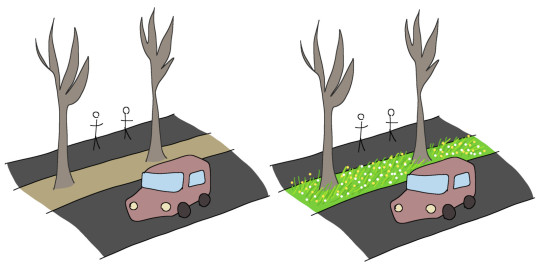#raingardens
Explore tagged Tumblr posts
Video
Oh man, that's near where I live!
streets with rain gardens and streets without
15K notes
·
View notes
Text
#RainGarden#SustainableGardening#EcoFriendlyGarden#WaterConservation#GreenGardening#RainwaterManagement
0 notes
Text
Landscape - Contemporary Landscape

Photo of a mid-sized contemporary drought-tolerant and shade backyard landscaping with decking in summer.
0 notes
Note
the thing about the raingardens thing is its like putting a bit of aloe vera on a shrapnel wound.
the only way to make suburbia not apocalypticly environmentally destructive is to... destroy suburbia
you're talking to an ecologist, anon
109 notes
·
View notes
Text
So I kind of want another fish after losing Nyoom. Even with six fish in there it just looks so empty without her.
Does anyone have any recommendations for goldfish breeders?
I ordered from NextDayKoi earlier this year and they sent me two fish with ich :/ so they're off the list. Zhao's Fancies is also on my radar but I kinda want another single tail (although hggg calico orandas tempting). Man I wish Raingarden was still around...
12 notes
·
View notes
Text
I have now dug out, refilled, and planted up the second mini-raingarden on the other side of our front porch steps. Plants I've used so far include: riverbank lupine, Merten's sedge, common rush, slender rush, streambank violet, early blue violet, false lily-of-the-valley, springbank clover, and blue-eyed grass. This is approximately 75% of the commercially available plant species which are 1. native to my area, 2. capable of handling both moist soil and partial shade, and 3. not great big shrubs or trees. I'm not familiar with any of them. Once I've gone through a full year (and seen what thrives and what doesn't) I might add a few more things. I still need a lot more rocks, but I can't pay for rocks, so I'm watching the free sites closely.
5 notes
·
View notes
Text














( these are also older so i didn't make Trish's yet. Some day i promise 🙏 )
More headcanon stuff!!! Okay to use as icons with credit, blank may be used as well!!!
[ID: Abbacchio with Autistic, PTSD, Transfeminine, vampilacdernic, Blackpurplewhiteick, Celestifleurin, wrongsomian, selesilvic, happysadmemoric, celeseredess, Sapphilunic, Schizzlio, pastelgothcatgender, Gothicgender, Sapphic, Demisexual and Transgender flags behind her.
Bruno with Autistic, BPD, Futch Bi Lesbian, Genderfluid Fag, BORDERFPLOVEIC, Sapphilunic, Opalaestic, Momgender, Raingardenic, dawnoirosetta, Weirdthing, BLASWANTHiNG, and Zipper-Enigmic behind him.
Narancia with ADHD, HPD, Autistic, Aroace, Nonbinary, Genderfluid, GENDERFAIL/FAILGENDER, paradoxian, Cinnorigirl/Cinnorifem, luckthiefic, Scribblix, chaoscatgender, xenochaosfluix, raincorean, and Brightcanvasic behind them.
Giorno with the Autistic, "adhd, hypersexuality, hpd, dpd, madd, and bpd" (merged flag), Transgender, Transmascfem, 🥀EMOJIC, GENDERROSE, Rosequartzaestic, TRANSMASCROSE, stargirl, nightrose, Aurumluxic, yellowgender, and FAGDYKE GAYBIAN flags behind xer.
Fugo with Autistic, PTSD, FAGDYKE GAYBIAN, Agender, Abrosexual, Demiromantic, Heartbroken platonic trauma, Strawgirlflavic, Strawboyflavic, Strawberryfoodic, Liminalforestic, ㅤFLOURVEiNCEㅤ, Daffodilangfloric, GENDERPATCHED, and Sunrisetraumix behind him.
Mista with Autistic, ADHD, BPD, DPD, Trans masc, Achillean, Pan Gay, Bluegender, Redpresentic, GUNTHiNG, Pathetic-silly boy, Musefluid, ㅤRiERNALiㅤ, Aquatifungender, mistraender, BOYGIRL, and apolladox flags behind him. End of ID.]
8 notes
·
View notes
Text
okay BUT
IMPORTANT PSA
(for like the two people who’ll see this lol)
if you live in an area prone to algal blooms with storm drains, ie: wisconsin, those leaves CANNOT i repeat CANNOT leave your yard. If they do the get washed via the city water system straight into nearby rivers and lakes where they decompose into yummy yummy nitrogen which helps algae grow. Algal blooms are a huge problem and can even be toxic to humans, so if your city is asking you to rake them up its probably for good reason. If you want to keep the leaves chill. But do everything you can to reduce yard runoff. Maybe a nice raingarden with some native deeprooted plants and rocks!

125K notes
·
View notes
Video
youtube
Rain Garden Landscape Design
Rain Gardens Landscape Contractor
Rain Gardens by Tom
Are you looking for a great solution for all the water out of your downspouts?
A retention basin is a great way to collect rain and runoff on your property.
Rain gardens help improve water quality by up to 90% of chemical pollutants and nutrients.
Rain gardens are a natural based solution for helping with localized flooding.
Our rain gardens can include ornamental grasses, deep rooted perennials, low-growing shrubs and deer resistant plants.
Trees and shrubs in a rain garden help deflect water and slow it down.
And of course, one area of the rain garden will be the wettest and requires plants that tolerant of the wet conditions. Not every plant is suited for the wet area of a rain garden. Proper selection of plants for the success of the rain garden is critical.
Turing a low area in to a meadow rain garden will add in the enjoyment of watching the butterflies and the birds and the bees as they all take advantage of all the nectar producing plants.
By having a dry riverbed through your meadow rain garden gives the bed some structure and a place for the visitors to your meadow rain garden.
Contact Karen and Tom Grosh of Grosh’s lawn Service today at https://www.groshslawnservice.com/
https://www.groshslawnservice.com/rain-gardens/
#groshslawnservice #raingarden
1 note
·
View note
Text
Charity Spotlight: Defenders of Wildlife Northwest
The Defenders of Wildlife Northwest region is dedicated to promoting proactive wildlife conservation legislation at the state level for Washington, Oregon, and Idaho.
They focus on state wildlife agency reform and protection of threatened and endangered species. They advocate ways to reduce pollution in the Salish Sea with their Orcas Love Raingardens program and to remove outdated dams from rivers in the region to restore salmon.
#pnwsaves#conservation#endangered#nonprofit#charity#defender of wildlife#defenders#environmetalists#environment#endangered animals
0 notes
Text
What is Green Infrastructure?
Green infrastructure includes soil and vegetation, as well as permeable surfaces, that help manage stormwater runoff by capturing rainfall at its source and mimicking natural processes that improve the quality of water. It is used in urban environments to absorb and filter stormwater and reduce flooding while providing a natural habitat for wildlife. Surfaces like streets and roofs cannot absorb the polluted stormwater causing it to drain into the sewage system and contaminate the water supply with the trash and bacteria carried by the runoff. There are many different kinds of green infrastructure that can be implemented to store and purify this runoff and prevent it from being discharged into nearby bodies of water.
What are the types of green infrastructure?
Different types of green infrastructure include:
Green Roofs - Vegetation, such as grasses and wildflowers, on the roof of buildings that absorb rainfall and add insulation to the building
Downspout Disconnection - Reroute rainfall from draining into the sewer system to draining into rain barrels or permeable areas
Rain Gardens - Shallow basins containing native shrubs or grasses that absorb runoff from rooftops, streets, and sidewalks while providing habitats for wildlife
Bioswales - Deep channels filled with native plants that run along streets and parking lots to slow the release of stormwater and prevent flooding
Tree Canopies - Trees in developed areas that intercept stormwater before it reaches the ground and improve the ground’s ability to soak up water
Permeable Pavement - Pavement used for sidewalks, parking lots, or driveways that filter and store rainwater where it falls to purify the stored groundwater
What are the benefits of green infrastructure?
Besides managing runoff, green infrastructure also increases the amount of stored water that can be used instead of using municipal water supplies, which also helps to prevent droughts. Green infrastructure also improves air quality by reducing the urban heat island effect which increases air temperatures. Higher air temperatures cause an increase in smog, which can be absorbed by plants. Green infrastructure also has economic benefits, as improving water quality and decreasing air temperatures means less cost to provide energy for cooling and maintain water systems that require maintenance from overflow and erosion. Green infrastructure also adds an amenity to buildings while increasing their lifespan, making them more practical than traditional water management systems, or gray infrastructure, and less costly to implement.
How can you help?
Many cities have begun to create incentive programs for building owners to implement green infrastructure, including the DEP Green Infrastructure Grant Program in New York City. The program funds the installation of green roofs and bioswales on private properties. There are also measures to implement green infrastructure at a smaller scale at home by planting rain gardens with native plants and installing rain barrels to harvest rainfall. In these ways, and many more, green infrastructure can be incorporated into communities and reduce the effects of climate change.

Photo Source: https://www.flickr.com/photos/marc_smith/18410107686
Written by: Alessia Carreon - Intern of Moni K LLC

12 notes
·
View notes
Photo

I'm starting to walk more and more as the days go on. My energy and body are still heavily limited so I can't wander far from home. Luckily I don't have to go very far to see something pretty around here. I'm really glad we moved! #AJARTING #photography #naturephotography #madisonwi #wisconsin #wi #garden #gardening #raingarden #raingardens #tree #trees
#photography#madisonwi#wi#trees#wisconsin#raingarden#ajarting#tree#naturephotography#gardening#garden#raingardens
6 notes
·
View notes
Text
There are a lot of reasons depending on where you live. Some are just stupid city ordinances. Some are "if a two foot tall child can see the car coming they are less likely to run out in front of it chasing a ball" reasons. Some are "lyme disease is actually really prevalent in this area and we shouldn't depend wholly on the possums to take care of it" reasons. And some are actually ecological. I'll get to the big one, but I want to mention invasive bug species and their effect on trees. Emerald ash borer is a big one. Once a tree is infected there isn't anything anyone can do. It's a goner. The big problem is how quickly these things spread. Entire blocks can be infected by the time anyone catches on. Which means the city has to go through and cut down all of the infected trees. You may be looking at the remains of a massacre caused by an invasive species that the city hasn't had the time or funds to start replanting.
But let's talk bioretention facilities. These tend to serve one of two, if not both, functions. The first being storm water retention, meaning the purpose is to slow down how quickly storm water gets into the sewers to limit the need for overflow being used and ultimately reduce the amount of erosion around rivers and lakes. The second being purification. They are designed to basically pre-filter the water and remove pollutants before it hits the sewer system. Neat right?
They do this by the simple way of slowing down how long it takes water to filter through them. Either by creating a type of holding area (raingardens, the ponds in the middle of a cloverleaf exit on a highway) or by mixing a special blend of soil (generally very heavy on the compost 20-40%) to soak up more of the water. All of this reducing flooding which reduces erosion and water treatment systems being overloaded.
The thing is that for these to function properly you can only do certain plants or they get broken. Raingardens need plants that grow well in sand as they tend to be 60-80% sand. Boulevards needs to have the soil to soak up the water and complex root systems can reduce their efficiency.
So, hope that helps explain why you might see just grass growing where something else could be. There are a lot of possibilities and, yes, sometimes it's just that the city likes the look of the grass, but quite often it's something else.
I'm aware that most of the time when I don't get why something's done a certain way, and not the way I would think would be nicer, there's a perfectly sensible reason why that's not an option. But I'm also not a stranger to the concept that sometimes people who are not me are simply being irrational. That being said, I don't get why city areas need to have grass.
Every time I see a lawn somewhere this time of the year, it's fucking crisp. The grass is visibly dying. Like on one side of the road there's unworked land with lush green bushes and wild flowers and shit growing on the borders of a construction site, and on the other side there's a lawn, which is entirely yellowish brown. Save for the few green spots of native plants. I refuse to call them weeds, they fucking live here. Dandelions, clovers, anemones, wild chervil, there are so many completely wild flowers that are a joy to look at.
I get planting trees on the sides of the roads, they provide shade in the summer and improve mental health all year round, but why do we need grass. The grass isn't going to be nice to look at when the heat takes it down, I'm sure it costs the city infrastructure money to try to keep it alive, not to mention the water. I don't get why we wouldn't just let those little spots of land just go wild and grow whatever pleases to grow there. You can mow down the bushes and take out tree saplings once every two years or something so the whole city doesn't get overrun, but I don't get why we have to pay money to have the one on the left instead of letting it be like on the right. On its own. For free.

(I swear I am literally a professional artist and people have actually paid money for my illustrations. This isn't one of them.)
248 notes
·
View notes
Photo

#Repost by @herartsinaction ・・・ Check out the third site that is a part of the Adopt A Drain project! This summer, @sarahdrakeart and Noah (@h2youmn ) talked to the kids at @promiseneighborhoodcentralmn about #stormdrains #wastewater #drinkingwater #raingardens and more! Then Sarah was in #teachingartist #artistresidency with the kids to express their identity and community through designing the #stormdrainmurals thanks to funding from @unitedwaycenmn and #21CCLC. The five piece #stormdrainmural brings attention and awareness to the fact that our #stormwater and debris flows from waterfalls, creeks, lakes and rivers directly to the #MississippiRiver eventually the ocean, and also becomes our drinking #water in the Sherburne Soil & Water Conservation District. Our drinking water starts here. Help make sure only rain goes down the drain. You can protect our drinking water by Adopting-A-Drain at https://www.adopt-a-drain.org/ #cleanwaterstartswithyou https://www.instagram.com/p/CUM2jDkgvXB/?utm_medium=tumblr
#repost#stormdrains#wastewater#drinkingwater#raingardens#teachingartist#artistresidency#stormdrainmurals#21cclc#stormdrainmural#stormwater#mississippiriver#water#cleanwaterstartswithyou
0 notes
Photo

雨と休日。水と緑。流れてくるのはRenata Tebaldi の空恐ろしき神々しさを讃えた"Ave Maria"。 The greens in the water in rainy Saturday afternoon. #raingardens #rain #greens (カフェ&ギャラリー モアノ) https://www.instagram.com/p/BUBSkyvFsFP/?igshid=1qb3tbitjasqm
0 notes
Photo

Super excited!!! Our Tradeshow gear arrived today! You can find us next weekend at Seedy Saturday, March 21st from 10:30am-2:30pm at the Benson Centre! #seedysaturday #Cornwall #gardening #raingardens #veggiegarden #vegetablegardens #growyourfood #transitioncornwall https://www.instagram.com/p/B9kUyNChalO/?igshid=1dmd6r1v9f7bk
#seedysaturday#cornwall#gardening#raingardens#veggiegarden#vegetablegardens#growyourfood#transitioncornwall
0 notes